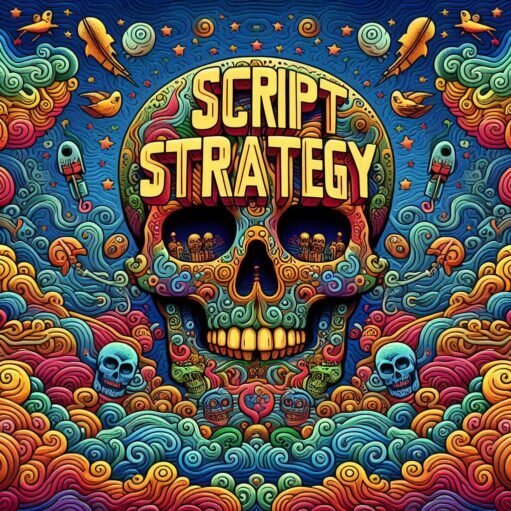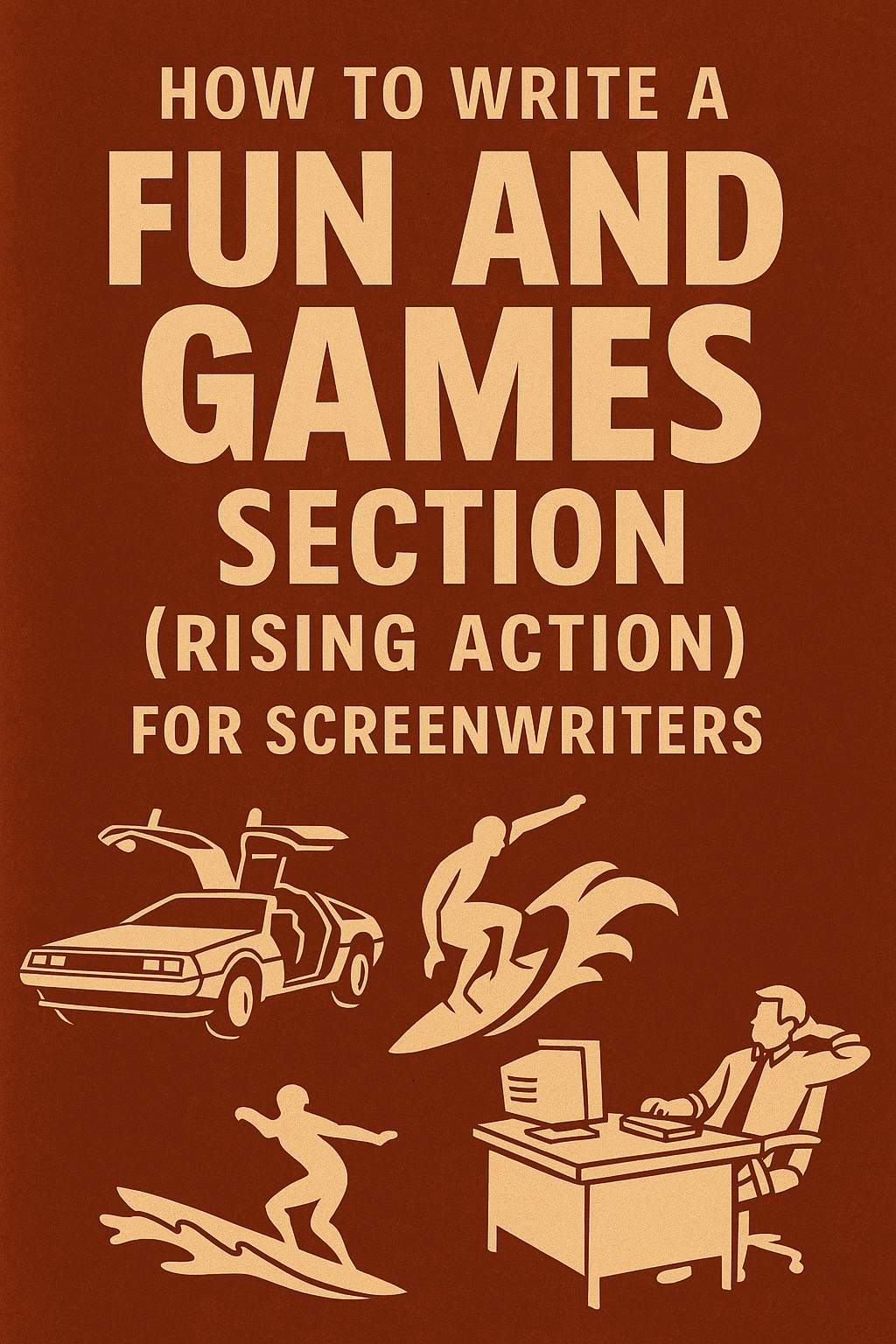How to Write a “Fun and Games” Section (Rising Action) for Screenwriters

Your characters have entered the New World of Act II.
Now what?
Act II can be notoriously difficult to nail down, especially for new writers. It’s not really clear how you’re supposed to deal with everything that has happened thus far and actually keep the momentum going all the way to the midpoint.
This means–in Snyder terminology–the Fun and Games section (also commonly referred to as the “Rising Action” section). It’s everything that helps That doesn’t necessarily tell us much about what it’s meant to be.
Perhaps more useful is Snyder’s other key description here, which is the “promise of the premise.” To unpack this a little bit, let’s clarify: think back to the logline of the film:
What would interest you about seeing this film?
For that matter, what interested you about writing it?
What questions does the premise beg?
Those are the sorts of questions that get answered in the Fun and Games section.
A Structural Definition of the Fun and Games Section
The Fun and Games sequence sits in Act IIa. It typically spans from around pages 25 to 50 in a 110-page script.
The reason it’s sometimes referred to as the Rising Action is that this is where the story would move upward–usually with positive things happening–before the Midpoint Reversal where things get complicated (which then leads to Falling Action, naturally).
This is the place where the protagonist explores her New World and chases to chase after her goal properly.
The other thing that this section allows/encourages is letting the film stretch its tires. This is where you get to answer all those questions begged by the logline:
What would the 1950s seem like to a person growing up in the 1980s?
What would happen if you really did choose to go to work and do absolutely nothing?
Is it possible to be fellated by a ghost?*
Put another way–something Snyder recommends–if a person asks you what the film is about, you’d almost certainly describe a scene from this section.
*I swear to dog I didn’t imagine this; for the record, Alex Garland references the moment in the Ex Machina script, too. Just watch it again and see for yourself.
Why the Fun and Games Section Matters
Screenplays live or die based on whether their second act delivers on the hook. The “trailer moments,” as it were.
Act I intrigues the audience, but the Fun and Games section makes them stay for the rest.
The Fun and Games section then entertains, delights, deepens, and–crucially–builds tension—yet it doesn’t actually resolve anything.
This point is where most set pieces are likely to happen. It’s a good place to inject comedy into films that aren’t necessarily thought of as funny. Think the Cairo market scene in Raiders of the Lost Ark.
It’s a place for a bit of levity even in the most serious films.
Start with Your Logline
The best Fun and Games sequences grow directly out of the logline.
What is the most appealing part of the premise? What would audiences pay to see?
Think about the Back to the Future logline:
A teenager in 1985 is mistakenly sent 30 years into the past where he unwittingly prevents his parents from hooking up.
Here are the questions that the premise begs:
- Marty encounters 1955 Hill Valley.
- How, precisely, does he disrupt their romance? (The peeping tom bit).
- How can this get more complicated? (Lorraine falls for “Calvin Klein”)
- What on earth was Doc doing in 1955?
- How quickly can we establish the new villain? (Biff, et al. and a truckload of cow shit)
Of course you remember these moments. In fact, these are probably the moments that you most remember from the film.
This is the place where you want to ask–what is that thing that this film delivers that no other film possibly could? This is the beating heart of the Fun and Games.
3 Core Functions of the Fun and Games
To write a strong Fun and Games section, think in terms of function.
Explore the New World
The protagonist is no longer in Kansas (metaphorically, but literally in The Wizard of Oz). The new world comes with new rules, dynamics, and opportunities.
Even when characters don’t enter a new location, they do enter a new social, psychological, or professional reality.
Point Break: Johnny Utah enters the adrenaline-fueled world of the surfers. He learns to surf, grows closer to Bodhi, and starts questioning his own identity. Even though the environment doesn’t fundamentally change, being accepted by the surfers means that Johnny’s spiritual vision has changed.
Office Space: Peter, post-hypnosis, finds himself miraculously without fucks. Even more miraculously, his world rewards him for this. The office might be the same, but its rules have changed.
Deliver the Concept
You’ll notice for any higher-concept films, this is where the premise is cashed out:
Time travel films get an exploration of the past/future; sometimes looping/butterfly effects occur.
Heist films enter the planning phase and often the showcase of the different team members’ skills.
Romantic comedy films have the game on. This is the basics of the courtship, complete with funny, awkward moments. (Always before the inevitable big split.)
Horror films, depending on intensity, will build eeriness at this point. You know bad shit is about to happen, but it’s only hinted at through tone. The true monster doesn’t appear until the midpoint. The best example of this is probably Alien. Everything builds from the time Dallas and the crew come back on the ship (Act II break) to the chest-bursting scene (Midpoint).
Slasher movies will kill the “jock” and the “slutty girl” here. Think The Texas Chainsaw Massacre. In these, the monster will appear at the Act II break.
Buddy comedies will highlight the contrast between the characters. Think Lethal Weapon.
Crucially, however, you’ll see that while there is a lot of, well, fun and games in the Fun and Games, the momentum still builds. There are moments where we can see clouds gathering…
Hint at Trouble Ahead
Rising action gonna rise.
The trick here is to escalate and foreshadow.
Yeah, things aren’t going wrong yet…
But something needs to feel off. This lays the groundwork for the Midpoint reversal. The audience needs to feel tension building without completely telegraphing the reversal.
In Point Break, Johnny makes progress with his case–or so he thinks–but as the audience, we already know that he’s pegged the wrong guys. So we’re interested to understand the payoff of the dramatic irony here.
In Office Space, Peter coasts along, doing very well—but the plan for the software is put into motion. He is unwittingly planting the seeds of his own destruction.
Examples
Back to the Future
- Marty navigates 1955 culture and etiquette.
- He disrupts his parents’ first meeting.
- He finds a younger, more idealistic Doc Brown.
- He accidentally invents the skateboard.
- He learns the origins of George’s submissive relationship with Biff.
This is where we feel the concept. These scenes, or some variant of similar ideas, is what you’d imagine if you pitched Back to the Future in a single sentence.
Point Break
- Genre: Action / Thriller
- Hook: An FBI agent goes undercover to identify a group of surfing bank robbers only to learn that his newfound surfing buddies might just be the criminals he’s after.
- Fun and Games:
- Johnny learns to surf and fails miserably.
- He bonds with Bodhi over philosophy and waves.
- He starts dating Tyler.
- He thinks he’s identified the suspects—of course he’s wrong here.
- He falls for the lifestyle, getting him in hot water at work.
- Johnny learns to surf and fails miserably.
This is where Johnny starts to lose his objectivity. His detective work suffers as he falls in love with the lifestyle he was meant to investigate.
Note how the rising action here is both internal and external.
Office Space
- Hook: A miserable office drone is hypnotized to stop caring; he then starts failing upward.
- Fun and Games:
- Peter skips work to go fishing, then guts the fish in the office. guts a fish in his office.
- Damn, it does feel good to be a gangsta. PC Load Letter no more.
- The relationship with Joanna begins
- He helps his friends with their “harmless” rounding error software.
- Peter skips work to go fishing, then guts the fish in the office. guts a fish in his office.
The fun of course lies in the reversal of expectation here. It’s deeply fulfilling to see Peter’s slacker philosophy succeed. (I mean real jobs fucking suck.) There’s still a wistful sense that it can’t last.
To wit, despite its playful tone, the structure escalates Peter’s risk while showcasing his (theoretically one-off) transformation.
How to Write a Strong Fun and Games Section
Let Characters Experiment
Characters don’t have it all figured out yet—but they’re willing to risk things.
Think in Vignettes or Set Pieces
Individual moments that show off the ideas:
The aforementioned Raiders market sequence, Daniel begins the housework in The Karate Kid, the fight sequences in Fight Club are all here (notably pre-Project Mayhem), all the benefits of giving the boss the keys to your flat for his tryst in The Apartment.
These scenes invariably explore the premise in action. They introduce a new facet of the world, test the character’s abilities thus far, and hint toward coming danger.
Watch how each beat feels slightly more extreme than the last. It could be funnier, weirder, more dangerous, etc. but it needs to build momentum.
Common Mistakes
Treating Fun and Games as Filler
The Fun and Games is more than simply “cool stuff.” It needs to advance character, deepen theme, and build tension.
“Everything Goes Right”
Good Fun and Games sequences have undercurrents of trouble. Foreshadow the conflict of the Midpoint. The reversal needs to be earned.
Losing the Hook
This is a sort of ludicrous mistake–but if people forget what your movie’s about during Act IIa, you’re doing something wrong. Scrap what you have any go back to the fucking premise already.
The Signature
The Fun and Games section is the story’s unique fingerprint. Its signature. It makes the logline come alive. Let the premise run wild.
More often than not, it’s this section that gets your script optioned or shared.
Exercise: The Trailer Sequence
Pick a concept you’re working on.
Write a scene–or maybe just identify a beat–that would belong in the Fun and Games section. Ensure that:
- It reflects the premise (what makes your story different).
- It explores the new world or status quo.
- It’s visually or tonally compelling (something for the trailer).
- It contains the seed of future conflict (again, often in trailers).
Just write one scene where your idea feels most alive. No need to resolve anything. That’s not this part of the film.
Make it something you–and other people–would like to see more of. This is your story’s fun.

